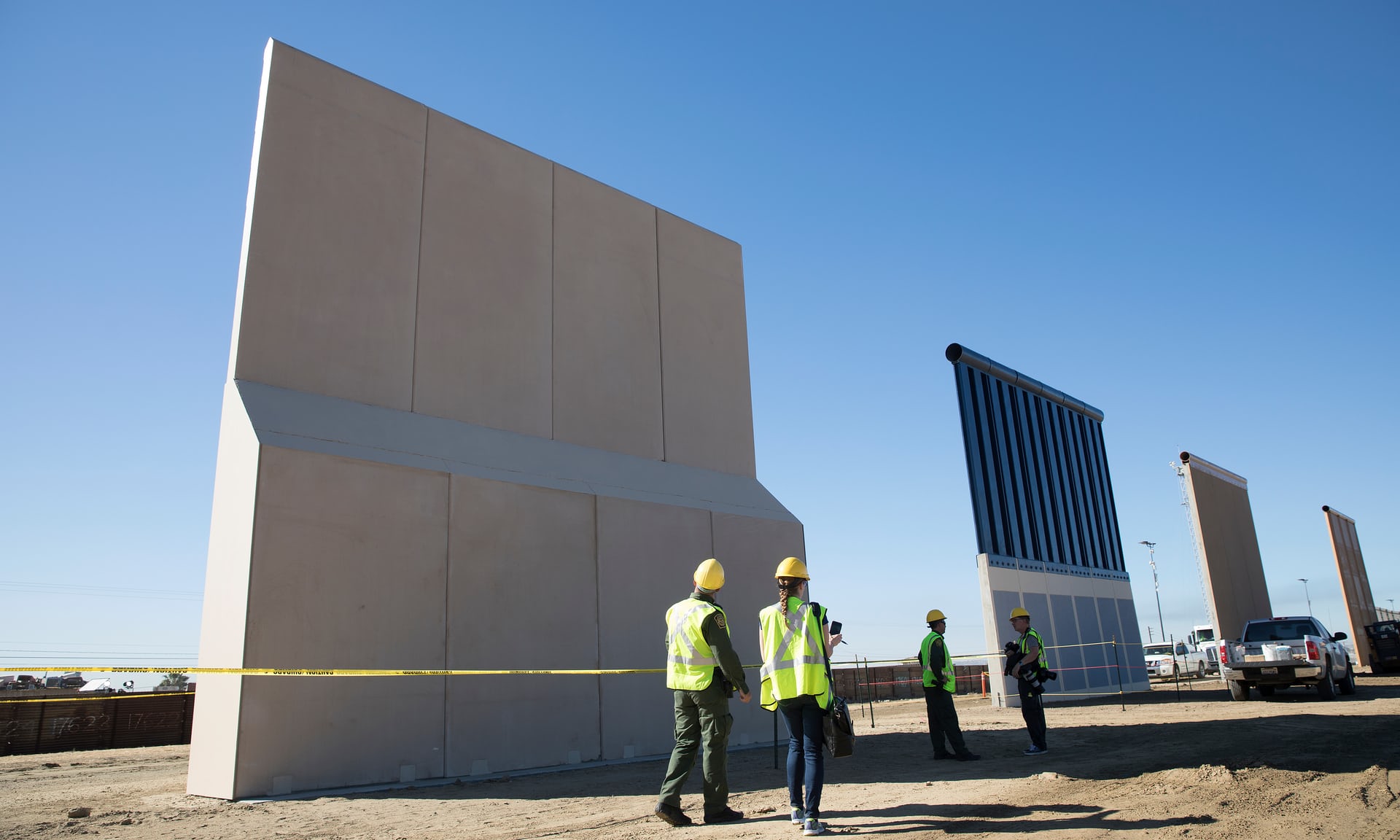by Julia Carrie Wong
Reported by the Guardian — Between San Diego and Tijuana, eight prototype border walls are ready for testing – but will any get built, and will it make a difference if they do?
It’s 9:15 a.m. and Ralph DeSio of US customs and border protection (CBP) is standing at the front of a tour bus full of journalists, pointing out notable features of the fencing that separates the United States from Mexico.
Furthest south is the 10ft tall primary fence – a low-slung structure of rusted, corrugated steel salvaged from Vietnam war-era helicopter landing pads. About 100 yards north is the secondary fence, 18ft of steel mesh added in the 1990s to create an “enforcement zone” between the two fences.
The scene feels a bit like the film Jurassic Park: a jovial guide explains how the fence will keep sightseers safe from untold terrors. This fence, though, is designed to keep out people, not unadvisedly resurrected dinosaurs.
The bus moves east from the Otay Mesa border crossing, to a site where eight brand new edifices – 30ft tall and 30ft wide – arise from the desert like a postmodern art exhibition.
These are prototypes for Donald Trump’s “big, beautiful wall”: eight designs selected by CBP from hundreds of entrants in a bidding process that began in March. Contractors had 30 days to construct the prototypes and, in late November, the concrete and steel edifices will be tested to see how they hold up against attempts to climb over, tunnel under, or bash through them.
At that point, according to the Trump campaign narrative, a winner would be selected and the process of erecting the chosen design across the United States’ 2000-mile southern border would begin, at an estimated cost of $21bn. But the CBP agents ferrying TV crews and photographers to the construction site were noncommittal about the prospect of this bidding process actually leading to a grand prize.
“Ultimately, the winner is the US government,” said Roy Villareal, chief of the San Diego border patrol sector. The process has provided the government with new ideas for border infrastructure, he said, so even if Congress does not approve funding for the wall, the agency can use aspects of the designs as it replaces and repairs existing fencing.
“Irrespective of whether the border wall is funded,” he said, “there is always funding for maintenance.”
Villareal demurred from picking a favorite of the eight, saying that he would wait for the testing, but DeSio praised the easternmost model – a solid concrete structure with terracotta colouring and a slightly tapered profile – as “svelte” and something he wouldn’t mind having enclosing his garden. Still, DeSio pointed out that the wall by itself is no panacea: “You can’t just lay a wall out there and say, ‘That’s it.’”
Jason Bush, another CBP agent, concurred, and said that he would personally prioritize spending money on personnel. “If the wall is there and someone gets over and is working me over,” he said, “the wall isn’t going to reach down and help me.”
The border wall is highly controversial and the bidding process was politically fraught, with major global contractors eschewing the opportunity and several state and local governments proposing blacklists of companies involved. But anticipated protests at the construction site never materialized, with local immigrant-rights activists choosing to greet the exercise with what San Diego photographer Maria Teresa Fernández called “the sound of silence.”
Fernández has been documenting the border fence since 2000, and she called the new models “a symbol of weakness”. The prototype site is closed to the public, but easy to view from south of the primary wall, in Tijuana’s Rancho Escondido neighborhood, where she has climbed up a little hill of dirt and debris to look over the corrugated steel fence and track the construction of the prototypes day by day.
She thinks of the wall as a living being, one that she’s been in a complicated relationship with for 17 years. “It was born, it’s growing, it’s reproducing, it changes, and I hope it will die someday,” she said. “I wish with all my heart to be able to live long enough to see it die.
“It’s hard to think of that, but we all have dreams.”
Residents of the impoverished neighborhood thought little of the efficacy of the new wall samples that jutted above the fence. Guillermina Fernández, who sells plants from her neat little house abutting the fence, complained that noise from the construction began early in the morning, but was otherwise disinterested. “It doesn’t affect us,” she said in Spanish.
Magdalena Palacios, whose eclectic home overflows with the car parts she salvages from the nearby recycling centre, can see the tops of the prototypes from a bench outside her front door. The 57-year-old lived in East Los Angeles for 16 years, but moved back to Tijuana after the death of her American husband.
“Anywhere, anyhow,” Palacios said, “people will continue to cross.”
At 1:30 p.m. every Sunday, as border patrol agents prepare to close off the site for another week, a pair of pastors lead a service across and through the border.
Guillermo Navarrete, the Mexican priest, said that he works hard to convince migrants in Tijuana not to attempt to cross the border, but to stay and live and work in the city instead. “We tell them there is no American dream any more,” he said. As for Trump, he added: “He is sick. We need to pray for him.”
John Fanestil, the pastor on the American side of the fence, saved his politics for his sermon. Reading from the Book of Isaiah, he preached: “And it will be said: ‘Build up, build up, prepare the road! Remove the obstacles out of the way of my people.’” (By the Guardian).



